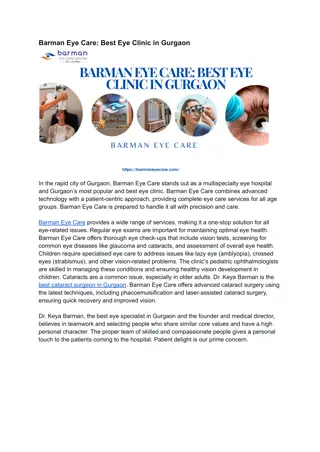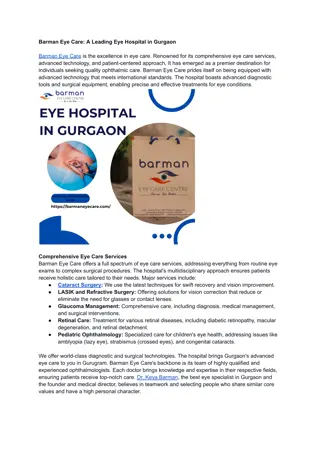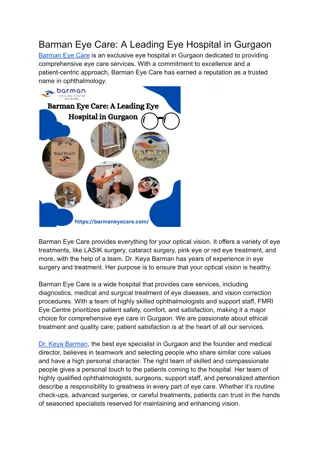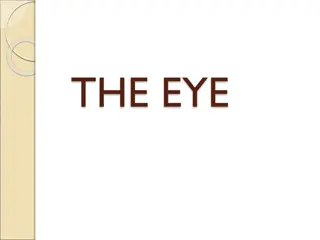Understanding Common Eye Problems and Functionality
Explore the important structures of the eye, their functions, changes in the pupil and iris in different light conditions, how the eye focuses on near and distant objects, common eye defects like myopia and hyperopia, and their treatments. Engage in activities to enhance learning about eye anatomy and visual impairments.
Download Presentation

Please find below an Image/Link to download the presentation.
The content on the website is provided AS IS for your information and personal use only. It may not be sold, licensed, or shared on other websites without obtaining consent from the author. Download presentation by click this link. If you encounter any issues during the download, it is possible that the publisher has removed the file from their server.
E N D
Presentation Transcript
Common problems of the eye Do now activity: 1. Name 8 important structures found in the eye 2. Describe the function of four of these structures 3. Explain the changes that occur to the pupil and iris in dim and bright light conditions.
Progress indicators GOOD PROGRESS: Describe how the eye focuses on near and distant objects Describe the symptoms and causes of some of the most common defects of the eye OUTSTANDING PROGRESS: Explain how new technologies have been able to overcome some of these common defects
Accommodation ~ Seeing distant and nearby objects In pairs each of you will receive information on either how the eye focuses on a nearby object or on a distant object. Each one, teach one Task: Teach each other about the information you have been give and without copying from the information sheet complete the following tasks: 1. Describe what happens to the lens in order to focus on: a) a distant object b) a nearby object 2. Explain what happens to the ciliary muscles and suspensory ligaments in order to bring about these changes in the lens.
Self-assessment: 1. a) In order to focus on a distant object the lens becomes less convex, therefore flatter, so the lights rays are only refracted a small amount. b) In order to focus on nearby objects, the lens becomes more convex, rounded, in order to refract light rays strongly so they focus on the retina. 2. When focusing on a distant object the ciliary muscles relax and the suspensory ligaments contract, pulling the lens flat and thin. When focusing on a nearby object the ciliary muscles contract and the suspensory ligaments relax making the lens more rounded and quite thick.
Common defects of the eye As people age they can start to notice their eye sight deteriorating, this is often due to the lens hardening and accommodation becoming more difficult. But there are problems which can affect people of all ages, two of the most common is myopia (short sightedness) and hyperopia (long sightedness). Task: Use the posters of information around the room to complete the fact file on myopia and hyperopia.
Problem: Myopia Problem: Hyperopia Self-assessment: Diagram: Diagram: Description: -Long distance objects are blurry, nearby objects are in focus. -The light is focused in front of the retina. -Very curved lens or the eyeball is too long. Description: -Long distance objects are in focus, nearby objects appear blurred. -The light is focused behind the retina. -Lens that is too flat or because the eyeball is too short. Treatment: Wear glasses with a convex lens, this brings the light rays together more before they reach the eye itself. Now the thinner lens can bring the rays of light into perfect focus on the retina. Treatment: Wear glasses with a concave lens, this spreads out the light from distant objects before it meets the eye and results in the light being brought into perfect focus on the retina.
Overcoming common eye defects Task: In groups, read the information cards on the roles of new technologies and materials in overcoming common problems of the eyes and complete this table Treatment Advantages Disadvantages Replacing lenses Contact lenses Laser eye surgery
Self-assessment: Treatment Advantages Disadvantages Another lens can be added inside the eye to correct the defect permanently Can cause damage to the retina, infection and cataracts developing if natural lens left in place Replacing lenses Cannot be seen Far more convenient Hard contact lenses are durable and last a long time Soft contact lenses are more flexible and comfortable to wear Some soft lenses can be worn every day for a month. Can be used to treat myopia and hyperopia Contact lenses must be removed overnight and kept sterile to avoid infection. Soft contact lenses are not as durable. Contact lenses Laser eye surgery Only available to adults, with children could be damaging in the long run.
Exam-style question Q. Explain the problem of myopia and describe the treatment used to correct this condition. (3 marks) Mark Scheme: Myopia is when objects close up are seen in clear focus but distant object are blurred. 1 This is because the lens is too curved, or the eyeball is too long, and light is focused in front of the retina. 1 To correct this problem glasses or contacts lenses with a concave lens can be worn, this spreads the light from distant objects meaning the light is brought into clear focus on the retina. 1
Plenary: Anagram challenge Unscramble the following to identify a key word from the lessons we have covered on eyes: MYOPIA LENS CORNEA RADIAL CONVEX RETINA SCLERA a) PYIAOM b) NLES c) ORCAEN d) DRALIA e) VOXCEN f) TENIAR g) LERACS Extra Challenge: Come up with a definition for each key word!
Focusing on a distant object: Focusing on a nearby object: Lens less convex - flatter Lens more convex - rounded The light that reaches your eyes from distant objects is travelling in almost parallel rays. The light that reaches your eyes from nearby objects is diverging very strongly. To focus on a nearby object the ciliary muscles contract so that suspensory ligaments loosen. The lens is then thicker and more curved. It refracts light rays strongly so they are focused onto the retina. To focus on a distant object the ciliary muscles relax so the suspensory ligaments are pulled tight and the lens is pulled flat and thin. It only refracts light rays slightly so they are focused on the retina. Ciliary muscles contract Ciliary muscles relax Suspensory ligaments pulled tight Suspensory ligaments relax
Problem: Problem: Diagram: Diagram: Description: Description: Treatment: Treatment:
With myopia distance objects are blurry whilst nearby objects are in focus. The light is focused in front of the retina, so the images that actually land on the retina are out of focus and blurry. This can be the result of a very curved lens or the eyeball is too long. The most common way to fix this problem is for people to wear glasses with a concave lens, this spreads out the light from distant objects before it meets the eye. This results in the light being brought into perfect focus on the retina.
With hyperopia distance objects are in focus whilst nearby objects appear blurred. The light is focused behind the retina, so the images that actually land on the retina are out of focus and blurry. This can be the result of a lens that is too flat or because the eyeball is too short. The most common way to fix this problem is for people to wear glasses with a convex lens, this brings the light rays together more before they reach the eye itself. Now the thinner lens can bring the rays of light into perfect focus on the retina.
Replacing lenses In order to correct long or short sightedness another lens can be added inside the eye to correct the defect permanently. There are two main techniques, in one a permanent contact lens is implanted in the eye and the natural lens is left in too. Another treatment involves the removal of the faulty lens first, before implanting an artificial lens. Whilst this treatment permanently corrects the visual impairment it can also cause damage to the retina, infection and cataracts developing if natural lens left in place. Contact lenses Contact lenses carry out the same job as conventional glasses but they cannot be seen, which is far more convenient for the everyday lives of most people. Hard contact lenses are made of durable material which lasts for a long time but they have to be removed overnight and kept sterile, to avoid infection. Many modern contacts are soft lenses, this makes it more flexible and comfortable to wear but not as durable. Some soft lenses can be worn every day for a month, like hard contacts they need to be kept in sterile solution overnight. Others are disposable, after being worn once they are thrown away. Laser eye surgery Lasers can be used to treat myopia and hyperopia, for myopia the thickness of the lens is reduced so the cornea refracts light less strongly. For hyperopia lasers are used to change the curve of the cornea so it refracts light from closer objects more effectively. This treatment is only available to adults, as with children their eyes are still developing which could be hugely damaging in the long run.






















